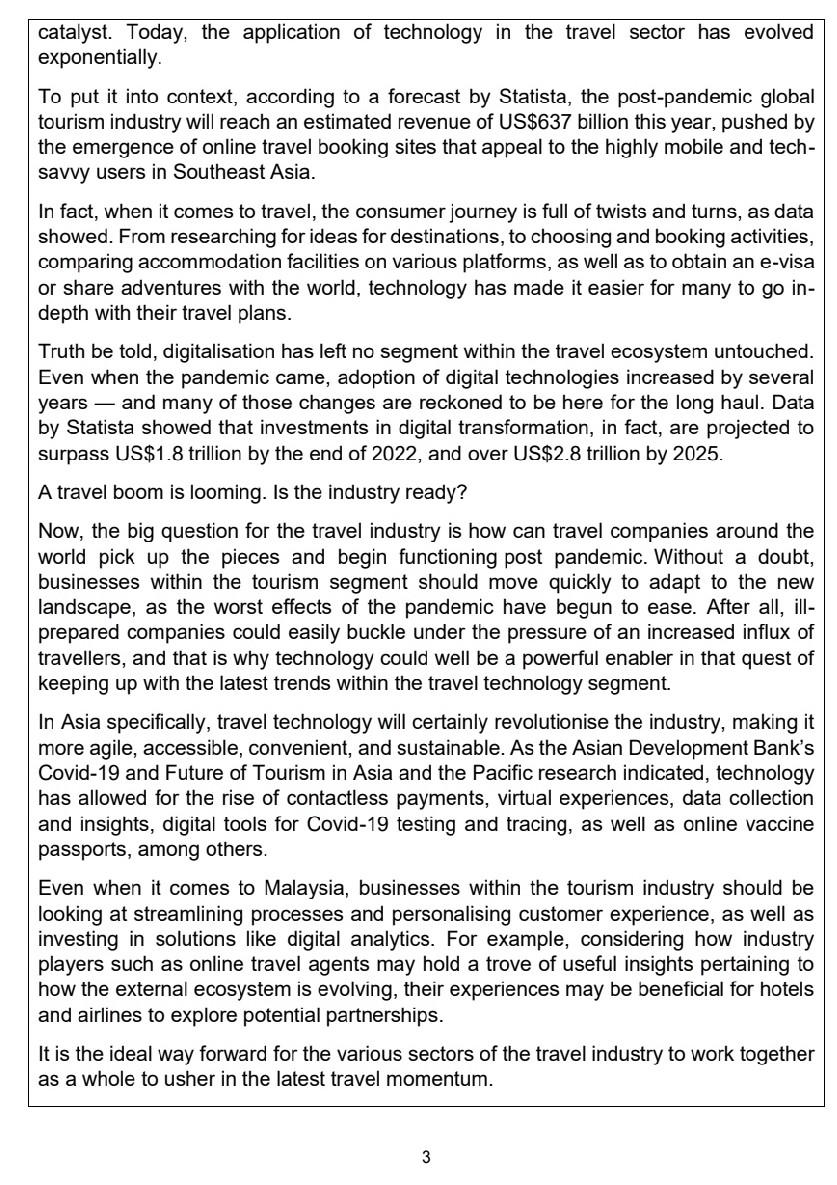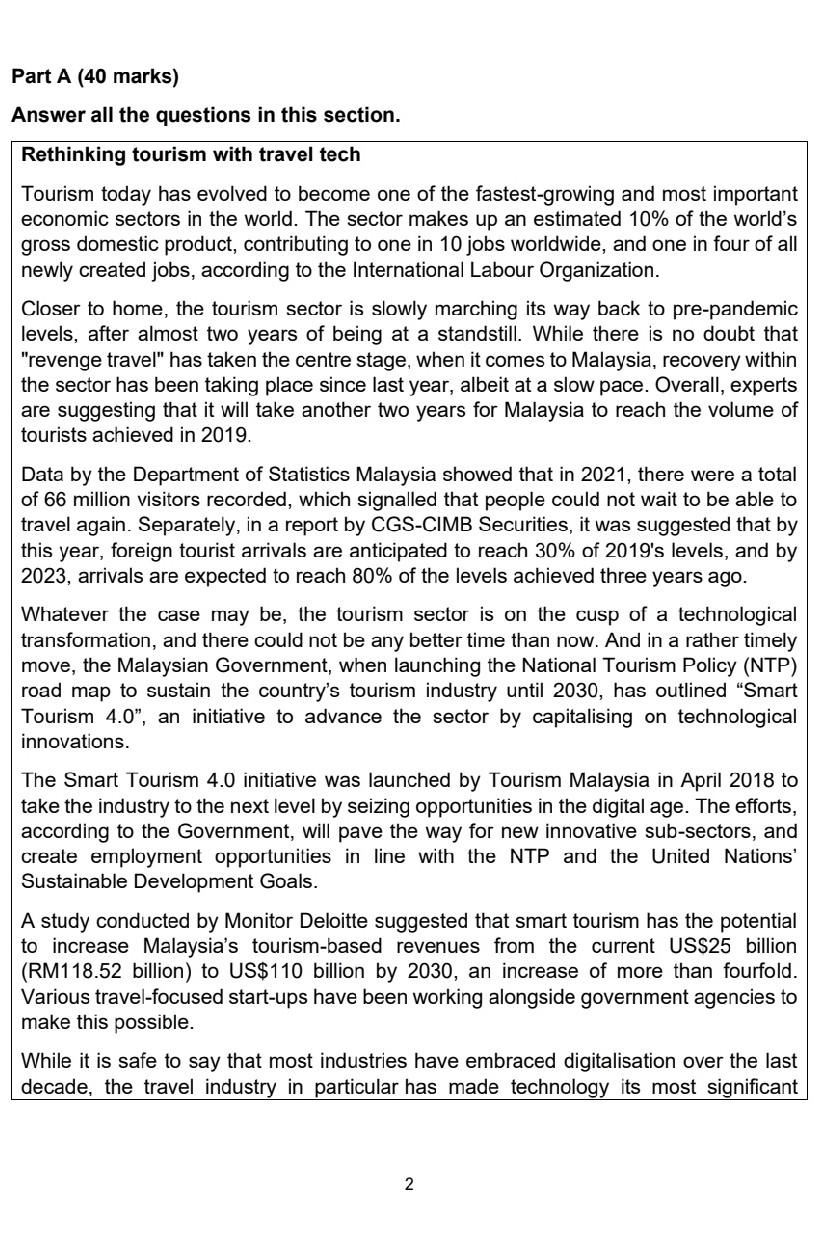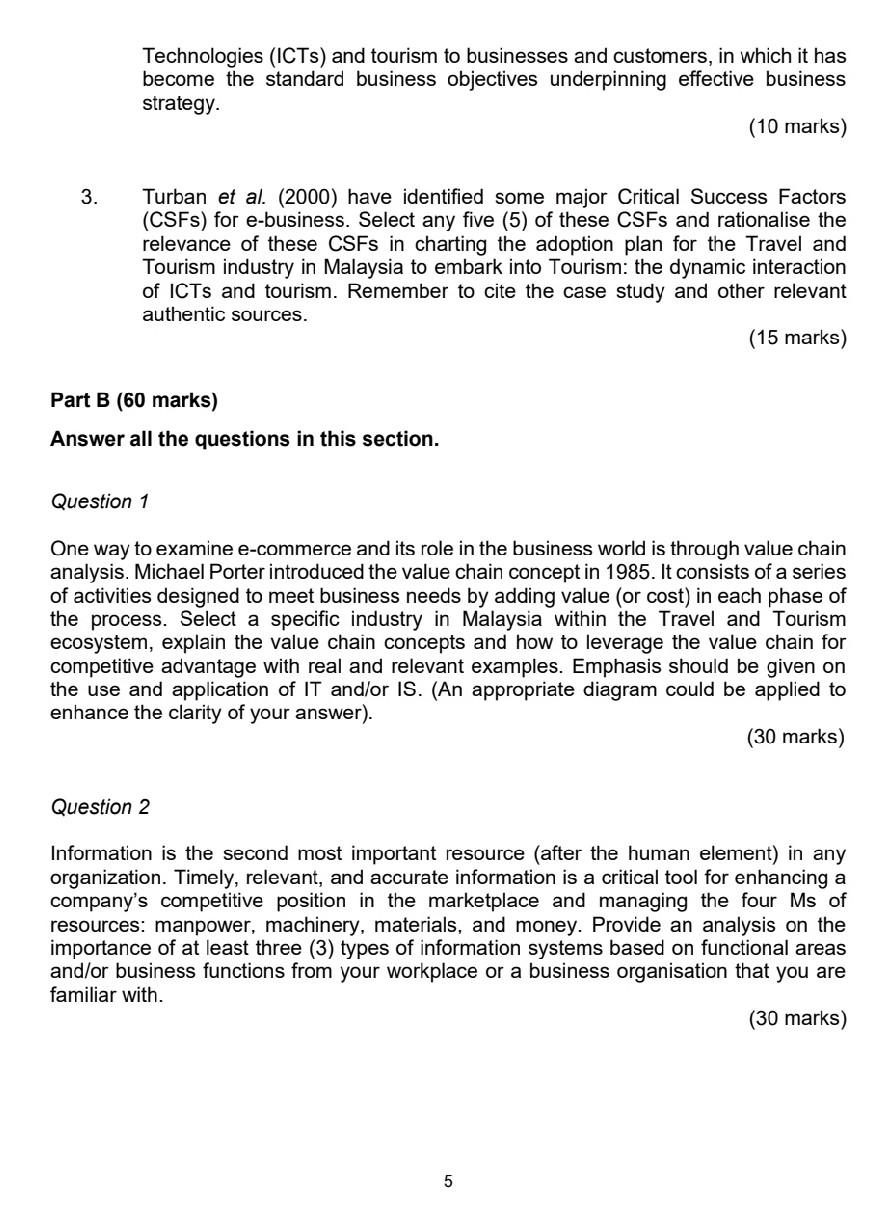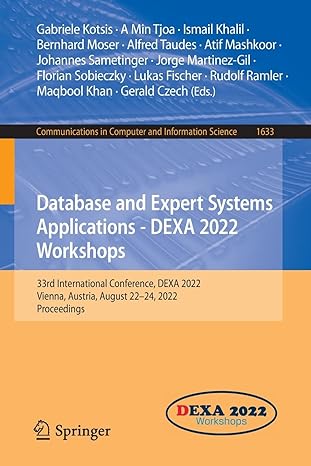



catalyst. Today, the application of technology in the travel sector has evolved exponentially. To put it into context, according to a forecast by Statista, the post-pandemic global tourism industry will reach an estimated revenue of US $637 billion this year, pushed by the emergence of online travel booking sites that appeal to the highly mobile and techsavvy users in Southeast Asia. In fact, when it comes to travel, the consumer journey is full of twists and turns, as data showed. From researching for ideas for destinations, to choosing and booking activities, comparing accommodation facilities on various platforms, as well as to obtain an e-visa or share adventures with the world, technology has made it easier for many to go indepth with their travel plans. Truth be told, digitalisation has left no segment within the travel ecosystem untouched. Even when the pandemic came, adoption of digital technologies increased by several years - and many of those changes are reckoned to be here for the long haul. Data by Statista showed that investments in digital transformation, in fact, are projected to surpass US\$1.8 trillion by the end of 2022, and over US 2.8 trillion by 2025 . A travel boom is looming. Is the industry ready? Now, the big question for the travel industry is how can travel companies around the world pick up the pieces and begin functioning post pandemic. Without a doubt, businesses within the tourism segment should move quickly to adapt to the new landscape, as the worst effects of the pandemic have begun to ease. After all, illprepared companies could easily buckle under the pressure of an increased influx of travellers, and that is why technology could well be a powerful enabler in that quest of keeping up with the latest trends within the travel technology segment. In Asia specifically, travel technology will certainly revolutionise the industry, making it more agile, accessible, convenient, and sustainable. As the Asian Development Bank's Covid-19 and Future of Tourism in Asia and the Pacific research indicated, technology has allowed for the rise of contactless payments, virtual experiences, data collection and insights, digital tools for Covid-19 testing and tracing, as well as online vaccine passports, among others. Even when it comes to Malaysia, businesses within the tourism industry should be looking at streamlining processes and personalising customer experience, as well as investing in solutions like digital analytics. For example, considering how industry players such as online travel agents may hold a trove of useful insights pertaining to how the external ecosystem is evolving, their experiences may be beneficial for hotels and airlines to explore potential partnerships. It is the ideal way forward for the various sectors of the travel industry to work together as a whole to usher in the latest travel momentum. 3 Tourism today has evolved to become one of the fastest-growing and most important economic sectors in the world. The sector makes up an estimated 10% of the world's gross domestic product, contributing to one in 10 jobs worldwide, and one in four of all newly created jobs, according to the International Labour Organization. Closer to home, the tourism sector is slowly marching its way back to pre-pandemic levels, after almost two years of being at a standstill. While there is no doubt that "revenge travel" has taken the centre stage, when it comes to Malaysia, recovery within the sector has been taking place since last year, albeit at a slow pace. Overall, experts are suggesting that it will take another two years for Malaysia to reach the volume of tourists achieved in 2019. Data by the Department of Statistics Malaysia showed that in 2021, there were a total of 66 million visitors recorded, which signalled that people could not wait to be able to travel again. Separately, in a report by CGS-CIMB Securities, it was suggested that by this year, foreign tourist arrivals are anticipated to reach 30% of 2019 's levels, and by 2023 , arrivals are expected to reach 80% of the levels achieved three years ago. Whatever the case may be, the tourism sector is on the cusp of a technological transformation, and there could not be any better time than now. And in a rather timely move, the Malaysian Government, when launching the National Tourism Policy (NTP) road map to sustain the country's tourism industry until 2030, has outlined "Smart Tourism 4.0", an initiative to advance the sector by capitalising on technological innovations. The Smart Tourism 4.0 initiative was launched by Tourism Malaysia in April 2018 to take the industry to the next level by seizing opportunities in the digital age. The efforts, according to the Government, will pave the way for new innovative sub-sectors, and create employment opportunities in line with the NTP and the United Nations' Sustainable Development Goals. A study conducted by Monitor Deloitte suggested that smart tourism has the potential to increase Malaysia's tourism-based revenues from the current USS25 billion (RM118.52 billion) to US $110 billion by 2030, an increase of more than fourfold. Various travel-focused start-ups have been working alongside government agencies to make this possible. While it is safe to say that most industries have embraced digitalisation over the last decade, the travel industry in particular has made technology its most significant The way forward Take Traveloka, for example. As a leading travel and lifestyle platform, its selling point goes beyond just offering competitive airfares and hotel room rates. The platform has been offering various technology-based innovations to fulfil growing needs of consumers in travel and lifestyles. The company, even before the pandemic, has been tapping into data analytics to understand the evolving needs of consumers. Essentially, Traveloka found that technology also gave rise to more demand for convenient, connected experiences, especially among millennials who see value in managing every aspect of their digital lives online from a single platform. The approach has allowed Traveloka as a company to pivot to new business verticals while adjusting operating models in near real time. As the travel and lifestyle platform has also gathered expertise in data science, cybersecurity, and cloud-native architecture, today it can bring together data insights across Southeast Asia, all while formulating new solutions based on emerging demand. On the whole, to capitalise and continue to stimulate consumers' desire to get back out there and travel, travel companies should step up their game, and look for innovative ways to enhance travel experience. Overall, an overarching strategy of being data-driven, tech-enabled and humancentred is the way forward to deliver a more personalised experience. [Adopted from: Chan, A. (November 2, 2022). Rethinking tourism with travel tech. The Edge Market Online DigitalEdge section at: hhttps://www.theedgemarkets.com/article/rethinking-tourism-travel-tech, accessed on 5th January 2023. ] Questions 1. "This emerging new role of information Technology (IT) within organisations is the result of two concurrent and perhaps equally powerful forces, technology push and competitive pull." Provide your opinion on this statement with the supporting evidence from the case study as well as from other relevant contexts of eTourism in Malaysia. (15 marks) 2. The Internet possesses a combination of features that make it radically different from any other sales channel while cloud is the Internet-more specifically, it's all of the things you can access remotely over the Internet. Citing the relevance of the case study and other relevant sources, critically evaluate the benefits of eTourism: the dynamic interaction of Information and Communication Technologies (ICTs) and tourism to businesses and customers, in which it has become the standard business objectives underpinning effective business strategy. (10 marks) 3. Turban et al. (2000) have identified some major Critical Success Factors (CSFs) for e-business. Select any five (5) of these CSFs and rationalise the relevance of these CSFs in charting the adoption plan for the Travel and Tourism industry in Malaysia to embark into Tourism: the dynamic interaction of ICTs and tourism. Remember to cite the case study and other relevant authentic sources. (15 marks) Part B (60 marks) Answer all the questions in this section. Question 1 One way to examine e-commerce and its role in the business world is through value chain analysis. Michael Porter introduced the value chain concept in 1985. It consists of a series of activities designed to meet business needs by adding value (or cost) in each phase of the process. Select a specific industry in Malaysia within the Travel and Tourism ecosystem, explain the value chain concepts and how to leverage the value chain for competitive advantage with real and relevant examples. Emphasis should be given on the use and application of IT and/or IS. (An appropriate diagram could be applied to enhance the clarity of your answer). (30 marks) Question 2 Information is the second most important resource (after the human element) in any organization. Timely, relevant, and accurate information is a critical tool for enhancing a company's competitive position in the marketplace and managing the four Ms of resources: manpower, machinery, materials, and money. Provide an analysis on the importance of at least three (3) types of information systems based on functional areas and/or business functions from your workplace or a business organisation that you are familiar with. (30 marks)










